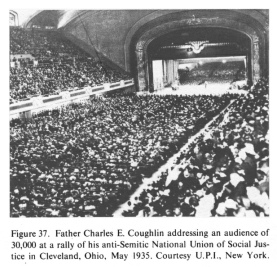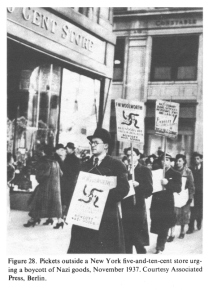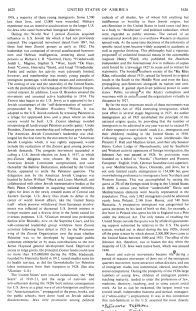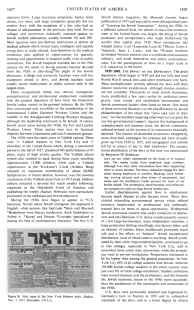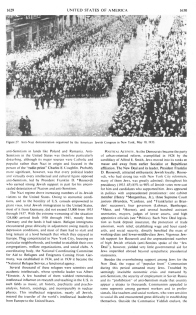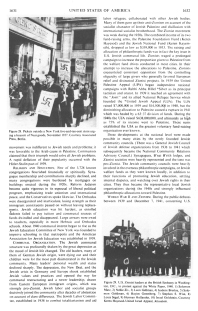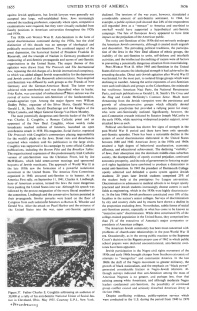Encyclopaedia Judaica
Jews in the "USA" 06: 1929-1939
Jews affected by the collapse of the stock exchange of 1929 - Jews at universities - anti-Semitism and the "Christian" Father Coughlin - 157,000 official German Jewish refugees - New Deal and Communist fantasy - Jewish education congregations - racist Zionist fantasy and money collections
from: Encyclopaedia Judaica (1971): USA; vol. 15
presented by Michael Palomino (2008)
| Teilen / share: |
Facebook |
|
Twitter
|
<THE IMPACT OF THE DEPRESSION.
[Affected Jews by the depression - sharper fight for employment - Jews at universities]
The great depression which began in 1929 and did not fully end until World War II struck Jews and other Americans very hard. Mass unemployment severely affected the Jews with their distinct economic stratification, although precise statistics are not available. Thousands of small Jewish businesses, many established a few years earlier by ambitious immigrants, were ruined, and established businessmen and Jewish communal leaders often fared no better. One result of these economic disasters was the abandonment by Jewish philanthropies of the claim that "Jews take care of their own", for the numbers requiring relief were far too great for any but governmental support. Against this backgrounds of unemployment and business crisis, the Jewish community suffered severely as the income of its institutions drastically declined. The income of charitable institutions dropped by more than half, campaigns for overseas aid were virtually given up from 1930 to 1935, and synagogues and schools fell far in arrears of pay to their employees. The occupational distribution of the Jews at this time was summarized by Benjamin M. Selikman:
"Jews are not widely represented on the farms or in manual jobs. The needle trades have employed large numbers, although even here other nationalities have been supporting them in recent decades. The heavy industries engage few Jews either among employers or workers. Banking, stock brokering, moving pictures and other forms of amusement, real estate and the distributive trades account for most of our Jewish wealth. The professions, small business, and white-collar occupations yield our large Jewish middle class."
[[At the same time the Communists were laughing at the Darwinist Capitalists because the "Soviet Union" officially had no economic crises. In real the "Soviet Union" was a crisis...]]
Earlier discrimination against Jews in employment became much sharper as jobs became fewer. Many Jews entered expanding governmental service which offered extensive employment to professional and technically trained Jews on terms of equal opportunity. Widespread Jewish communal concern that under conditions of depression and anti-Semitism U.S. Jewry would presently consist of a few large businessmen, many independent salesmen, a large proletariat drifting unwillingly into factory labor, and an element of restless, bitter intellectuals prompted much talk and a few efforts to "balance" Jewish occupational distribution, none of which came to anything.
Jewish youth, aided by their often impoverished families, continued to go to free colleges, especially in New York City, and to somewhat more costly state universities, while the prosperous went to private institutions. Proportions continued to be far higher than among the general population. In New York City 49% of all college students were Jewish, while the 105,000 Jewish college students in the entire country were just over 9% of total college enrollment. Student ambitions were toward business and the professions, and this foretold the Jewish economic future in the 1950s more accurately than the predictions of the sociologists and economists of the 1930s.
["US" anti-Semitism since 1933: Catholic populism - "radio priest" Charles E. Coughlin]
U.S. Jews were profoundly shocked and frightened by Germany's turn to Nazism in 1933 and its unheard-of treatment of the Jews, and to a lesser degree by official (col. 1628)
anti-Semitism in lands like Poland and Rumania [[Romania]]. Anti-Semitism in the United States was therefore particularly disturbing, although its major sources were Catholic and populist rather than Nazi in origin and focused in the person of the "radio priest" Charles E. Coughlin. Probably more significant, however, was that every political leader and virtually every intellectual and cultural figure opposed anti-Semitism, led by President Franklin D. *Roosevelt who earned strong Jewish support in part for his unconcealed detestation of Nazism and anti-Semitism. (col. 1629)
Encyclopaedia Judaica (1971): "USA", vol. 15, col. 1629-1630: Anti-Nazi demonstration
organized by the American Jewish Congress in New York, May 10, 1933
[[Other parts of the Roosevelt government - as, e.g., the department for interior affairs - were very anti-Semitic, and Roosevelt let them do, with anti-Semitic rules, with collaboration with the Third Reich industry for the war etc. The anti-Semitic parts of the Roosevelt government are not mentioned in Encyclopaedia Judaica, so Roosevelt is presented as a "holy" person for the Jews which is not true... ]]
Anti-Semitism in the form of social discrimination continued during the 1930s, but the chief distinction of this decade was an upsurge of ideological and politically motivated anti-Semitism. The combined impact of the great depression, the hysterical hatred of President Franklin D. Roosevelt, and the triumph of Nazism in Germany produced an outpouring of anti-Semitic propaganda and scores of anti-Semitic organizations in the United States.
[[Hitler and Roosevelt came both to power in early 1933 and were both celebrated as the "leaders" who would lead Europe and "America" out of their economic crisis. Hitler copied racism from the "USA" and headed his governmental anti-Semitism against the Jews which was partly done by private organizations also in the "USA"]]:
The major themes of this agitation were drawn from The Protocols and The International Jew [[published by the racist Henry Ford, see col. 1626]], repeating the old charges of a Jewish international conspiracy, to which was added alleged Jewish responsibility for the depression and Jewish control of the Roosevelt administration. Nazi-inspired anti-Semitism was diffused by such groups as the Friends of New Germany and the German-American Bund. The latter never achieved wide membership and was discredited when its leader, Fritz Kuhn, was convicted of embezzlement [[robbery of money]].
More serious was the revival of native American anti-Semitism of the fundamentalist, pseudo-agrarian type. Among the major figures were William Dudley Pelley, organizer of the Silver Shirts, Gerald Winrod, Gerald L.K. Smith, Gerald Deatherage and the Knights of the White Camelia, and Major General George Van Horn Moseley.
The most potentially dangerous anti-Semitic leader of the 1930s was Charles E. Coughlin, a Roman Catholic priest and an opponent of the New Deal.
Coughlin, whose weekly radio broadcasts reached millions of listeners, launched an open anti-Semitic attack in 1938. His magazine, Social Justice, reprinted The Protocols with Coughlin's commentary placing responsibility for the world's plight on the Jews. Street riots and disturbances occurred when vendors sold his publication in the large cities. Coughlin was supported in his campaign by some official Catholic publications, including the Boston Pilot and the Brooklyn Tablet. The organizational expression of this predominantly Irish Catholic version of anti-Semitism was the Christian Front, led by Joe McWilliams, which held street-corner meetings and sponsored boycotts of Jewish merchants.
The approach of World War II in the late 1930s saw the formation of a powerful isolationist movement in the United States. The America First Committee, organized in 1940, attracted anti-Semites to its banner. (col. 1655) [[...]]
The noisy anti-Semitism of the 1930s did not seriously endanger the American Jewish community, although it created much anguish and discomfort. The prevailing political traditions, the participation of the Jews in the New Deal alliance of ethnic groups, the inability of the anti-Semites to unite, self-defense and interfaith activities, and the intellectual discrediting of racism were all factors in preventing a potentially dangerous situation from materializing.
[[Hitler's Germany copied "US" racism against the Blacks and headed it against the Jews, and so did also white racists in the "USA". Anti-Semitism in the "USA" 1933-1939 was stirred by the Ministry of Interior and Roosevelt let it be. In the "USA" there were many restrictions against the Jews like in Germany 1933-1939: parks forbidden, banks forbidden, beach forbidden, clubs forbidden and so on. A great part of the Nuremberg laws were a copy of the racist law of the "USA" against the Blacks, compiled by a Swiss "racist expert" named Ernst Ruedin from "neutral" racist Switzerland of the Nazi times which - together with the racist "USA" - had a pioneer role in racist eugenics at this time...]]
[Influx of German Jews - 33,000 + 124,000 = 157,000 from 1933 to 1941 - foundation of the National Coordinating Committee - transfer of the intellectual leadership from Europe to the "USA"]
The Nazi regime drove increasing numbers of its Jewish victims to the United States. Owing to economic conditions, and to the hostility of U.S. consuls empowered to grant visas, total Jewish immigration to the United States most of it from Germany, did not exceed 33,000 from 1933 through 1937. With the extreme worsening of the situation 124,000 arrived from 1938 through 1941, mostly from Germany and the lands it had taken. Refugee immigrants encountered great difficulty in adjustment owing mainly to depression conditions, and most of them had to start and long remain at a level beneath that which they enjoyed in Europe. They concentrated in New York City, focusing on particular neighborhoods, and tended to establish their own congregations, welfare organizations, and social clubs. A coordinating body, the National Coordinating Committee for Aid to Refugees and Emigrants Coming Fro Germany, was established in 1934, and in 1939 it became the *National Refuge Service, a functional agency.
Several thousand of these refugees were scientists and academic intellectuals, whose symbolic leader was Albert *Einstein. A few hundred of them wielded tremendous intellectual influence on research and teaching in the U.S. in such fields as music, art history, psychiatry and psychoanalysis, history, sociology, and incomparably in nuclear physics. This intellectual migration, nearly all Jewish insured the transfer of the world's intellectual leadership from Europe to the United States. (col. 1629)
[[Addition: Boycotts and organization of Jewish emigration from Central Europe in the 1930s
The international Jewry with all it's organizations instigated an international boycott of the Third Reich and it's products 1933-1945. The center of the organization of the boycott were the criminal racist "USA", see *Boycott, anti-Nazi. One of the leading boycotting organizations was the Joint. The racist Third Reich organized some boycott days of Jewish shops, see *Boycott, anti-Jewish. German population did not follow the boycott or went shopping at the Jewish shop one day after.
Encyclopaedia Judaica (1971): "USA", vol. 15, col. 1631: Pickets outside a New York five-and-ten-cent store urging a boycott of Nazi goods, November 1937. Courtesy Associated Press, Berlin
The racist Third Reich organized - in coordination with Jewish organizations - the emigration wave of 100,000s of Jews (see *Germany), with capital transfer (see *Haavara), and also in Austria emigration was organized in coordination with Jewish organizations (see *Joint). Many Jews did not want at all to emigrate because they felt as "German" or "Austrian". The figures of emigration from central Europe 1929-1939 gives the Joint indicating that 440,000 Jews had emigrated. One can estimate that 10% were caught against because they were in continental western Europe which was occupied by Germany in 1940]].
POLITICAL ACTIVITY.
[Jews in "US" politics - New Deal ("Jew Deal") since 1933 - "Soviet Union" becomes a fantasy paradise of "equality"]
As the Democrats became the party of urban-oriented reform, exemplified in 1928 by the candidacy of Alfred E. Smith, Jews moved into its ranks en masse and away from earlier Socialist or Republican affiliation. The New Deal and its leader, President Franklin D. Roosevelt [[since 1933]], attracted enthusiastic Jewish loyalty. Roosevelt, who had strong ties with New York City reformers, many of them Jews, was greatly admired; throughout his presidency (1933-45) 85% to 90% of Jewish votes were cast for him and candidates who supported him.
Jews appeared in politics with unprecedented prominence: one cabinet member (Henry *Morgenthau, Jr.), three Supreme Court justices (Brandeis, *Cardozo, and *Frankfurter as Brandeis' successor), four governors (Lehman, Bamberger, *Meier, and *Horner), and several hundred assistant secretaries, mayors, judges of lower courts, and high appointive officials (see *Politics). Such New Deal legislation as bank deposit insurance, the protection of trade unionism, work relief, establishing wage and hour standards, and social security, directly benefited the mass of working-class and lower-middle-class Jews. Vigorous Jewish support for Roosevelt and the unprecedented number of high Jewish officials (anti-Semites spoke of the "Jew Deal"), however, yielded very little governmental aid for Jews imperiled abroad beyond sympathetic presidential statements.
Besides the overwhelming support among Jews for the New Deal, the vogue of "popular front" Communism during this period attracted many Jews. Troubled by seemingly insoluble economic crisis and menaced by anti-Semitism, the security of employment in Soviet Russia and its "prohibition" of anti-Semitism made that country appear a utopia to thousands. Communism appealed to some segments among garment workers and to professionals, like teachers and social workers, who were sensitive to social ills and encountered great difficulty in establishing themselves. Outside the Communist Yiddish enclave, the (col. 1630)
movement was indifferent to Jewish needs and problems; it was favorable to the Arab cause in Palestine. Communists claimed that their triumph would solve all Jewish problems. A rapid deflation of their popularity occurred with the Hitler-Stalin pact of 1939.
RELIGION AND EDUCATION.
[Jewish communities coming down in the economic crisis since 1929 - foundation of the Jewish Education Committee in 1940 - foundation of the American Association for Jewish Education in 1939]
Few of the 3,728 known congregations flourished financially or spiritually. Synagogue membership and contributions sharply declined, and many congregations were burdened by mortgages on buildings erected during the 1920s. Reform Judaism became quite vigorous in its espousal of liberal political program, emphasizing trade unionism and internal peace, and the Conservatives spoke likewise. The Orthodox were disorganized and inarticulate, losing strength as their immigrant constituents passed on without leaving replacements. Jewish education was hit hardest, as enrolled students failed to pay tuition and communal sources of funds dwindled and disappeared. Large arrears were owed to teachers, especially in more Hebraic and Orthodox schools. About 1940 communal interest began to rise as the Jewish Education Committee of New York was founded to improve schooling in that metropolis and the American Association for Jewish Education was established in 1939.
COMMUNAL ORGANIZATION.
[No stable structures during the economic crisis since 1929]
The Jewish communal structure was profoundly shaken by the great depression as the mood of Jewish life changed. The old leaders, many of them of German Jewish origin, were dying out and their children were for the most part disinterested in the Jewish community. Many leaders' personal wealth and status declined sharply. The depression, the New Deal, and the Jewish crisis in Germany and Europe shook established Jewish values and practices and opened the way for communal restructuring and a newer leadership, drawn from eastern European immigrant origins, which was strongly [[racist]] pro-Zionist. Jewish labor and socialist groups decisively joined the community after decades of abstention on account of class differences. The Jewish Labor Committee, established in 1934 to combat totalitarianism and aid (col. 1631)
labor refugees, collaborated with other Jewish bodies. Many of them gave up their anti-Zionism on account of the socialist character of Jewish Palestine and disillusion with international socialist brotherhood. The [[racist]] Zionist movement was weak during the 1930s. The combined income of its two fund-raising arms, the Palestine Foundation Fund (Keren Hayesod) and the Jewish National Fund (Keren Kayemeth), dropped as low as $339,000 in 1933. The raising and allocation of philanthropic funds was in fact the key issue in U.S. Jewish communal life. [[Racist]] Zionists waged a prolonged campaign to increase the proportion given to Palestine from the welfare fund drives conducted in most cities. In their attempt to increase the allocations to Palestine, [[racist]] Zionists encountered consistent opposition from the controlling oligarchy of large givers who generally favored European relief and distrusted [[racist]] Zionist projects.
[Collecting of money for Palestine - manipulation of the Jewish councils into racist Zionist events]
[[The fantasy of a peaceful "home land" for the Jews in Palestine grow that far the millions of $ were given not considering that this imperialist Zionist plan of a "Greater Israel" was a war trap against all Arabs]].
In 1939 the United Palestine Appeal (UPA) began independent national campaigns with Rabbi Abba Hillel *Silver as its principal tactician and orator. In 1939 it reached an agreement with the "Joint" and its allied National Refugee Service which founded the *United Jewish Appeal (UJA). The UJA raised $7,000,000 in 1939 and $14,500,000 in 1940, but the diminishing allocation to Palestine caused a rupture in 1941 which was healed by a 63:37 division of funds. During the 1940s the UJA raised $638,000,000, and ultimately as high as 75% of its income went to Palestine. These sums established the UJA as the greatest voluntary fund-raising organization ever known.
These developments at the national level were made possible in many cities by the newly founded Jewish community councils. (There was a General Jewish Council of Jewish defense organizations from 1938 to 1941 which subsequently became the National Community Relations Advisory Council). Synagogues, B'nai B'rith lodges, and [[racist]] Zionist societies were heavily represented and the tone was pro-Zionist. The Jewish community councils were heavily involved in the overseas philanthropic campaigns, or Jewish welfare funds as they were known locally, in addition to their functions or promoting Jewish education, settling internal disputes, and watching over Jewish rights in their cities. They thus became the representative local Jewish organizations during the 1940s and strongly influenced philanthropic allocations toward Palestine.> (col. 1632)
| Teilen / share: |
Facebook |
|
Twitter
|
 previous
previous

